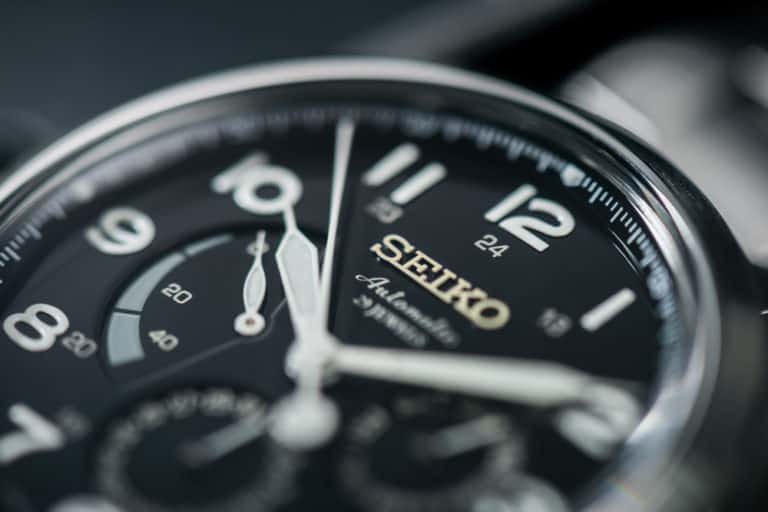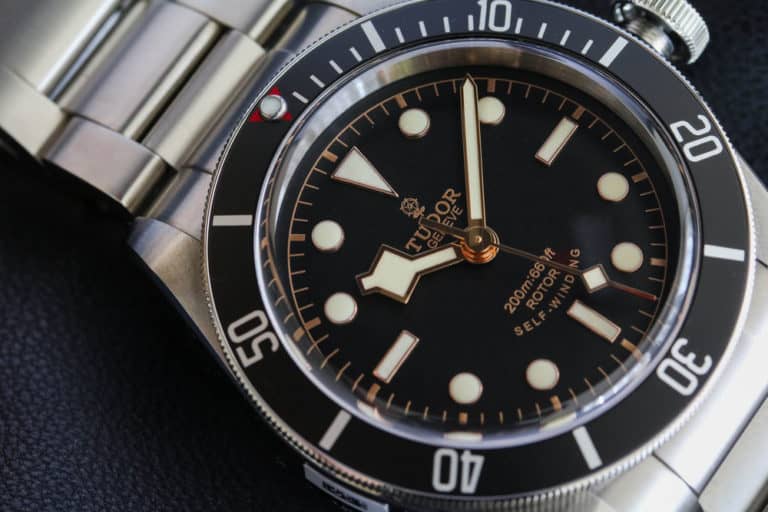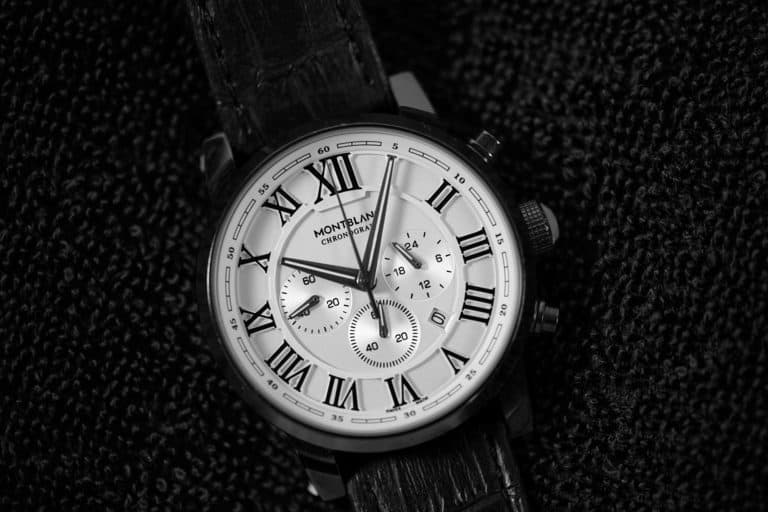Editorial credit: classic topcar / Shutterstock.com
The watch has been one of humanity’s most endearing inventions, and since its inception, there have been some truly memorable timepieces. But which one could be considered the most iconic watch of all time?
The Rolex Submariner, Omega’s Speedmaster, and Tag Heuer’s Monaco are all up there, but not every iconic watch costs thousands. Casio’s Datamaster or ‘calculator watch’ and their G-Shock range are easily recognizable, too, as are pieces from Breitling, Patek Phillipe, and Seiko.
Let’s take time and examine what it means to be an icon and what qualifies watches as iconic in a world with thousands of models to choose from; plus, we’ll list the top 10 most iconic watches ever produced.
What Makes A Watch Iconic?
Before we look at the timepieces on this list, there are some elements to consider when labeling a watch or any other item as iconic.
The Most Iconic Watches Are Recognizable
The first of those criteria is recognisability. For anything to become an icon, it must be instantly and widely recognizable.
When we look at some of the world’s most iconic brands like Apple, Microsoft, and Mercedes Benz, most people immediately know and recognize their logos and instantly associate them with luxury or performance in their respective fields.
This is also why watch brands like Rolex are iconic, as they have been seen on the wrists of the rich and famous and linked to success and power through marketing and association with high-profile events.
Omega became an icon through the James Bond movies as the spy has worn an Omega Seamaster in every film since 1995.
Tag-Heuer and Seiko made names for themselves as timekeepers in Formula One and the Olympic Games- all events that receive massive global media coverage and exposure.
Iconic Watches Have Distinct Features
While many iconic watches boast expensive decorations, with diamonds or crystal faces, some watches deserve iconic status for their simplicity and durability. Casio’s G-Shock range, for example, is some of the most durable and hardy watches ever produced.
Used by military special forces, these watches epitomize toughness and the ability to withstand environments in which much more expensive watches would crumble.
Iconic Watches Have A History
Another consideration for an icon is an achievement that sets it apart from other watches.
Omega’s Speedmaster has gone to the moon, and Rolex’s Deep Sea Challenge watch was strapped to the outside of James Cameron’s during his historic dive to Challenger Deep in 2012– the deepest point in the ocean, some 37000 feet straight down.
Not only did they spend 3 hours at the bottom of the sea exploring, but the Rolex Deep Sea Special, the watch that accompanied Jacques Piccard and Don Walsh to the Mariana Trench in 1960, was also present on that dive.
Now, let’s look at the ten most iconic watches.
#10 – Casio G-Shock DW-5000 C
The G-Shock range is the definition of toughness. Its creation was inspired by an engineer at Casio who wanted to create a watch that could meet the ‘triple 10’ standard of having a ten-year battery life, survive being dropped from 10m, and a depth rating of 10 bar.
Kikuo Ibe was inspired to develop this watch after a pocket timepiece given to him by his father dropped out of his pocket and broke, and nowhere is the saying ‘necessity is the mother of invention’ more true than this catalyst that led to one of the most iconic watches of all time.
After some 200 attempts to achieve the ‘triple ten’ standard, Kikuo’s team was inspired to create the watch from rubber after a visit to a children’s playground where they saw that rubber balls experience less impact in the center when bounced.
Today, the G-Shock is instantly recognizable and is the global standard for the toughest timepieces.
#9 – The Seiko Astron
Seiko is another iconic watch brand well-known and respected for its incredible accuracy, style, and durability.
But this particular model is special as its introduction to the market on Christmas Day in 1969 created a flurry of panic and activity in the watch market.
This was because this was the first ever quartz watch, and this mechanism’s extraordinary accuracy laid existing mechanical systems to waste.
Because the Astron came to market with an open patent, other watchmakers could develop and produce quartz-powered timepieces.
Even though most watches use the quartz mechanism, the Seiko Astron remains one of the most iconic watches thanks to the innovation that has changed the watch universe for all time.
#8- The Longines Lindbergh Hour Angle
This watch was designed by Charles Lindbergh and was based on the navigation system created by US Navy Officer Phillip Van Horn Weems in 1927.
This watch has a rotating disc that allows the wearer to synchronize the second hand with a GMT radio signal. The watch combines sextant and timepiece, allowing the navigator to determine position using a nautical almanac to calculate latitude and longitude.
For a timepiece that revolutionized navigation, the Longines Lindbergh Hour Angle watch is still desired by watch enthusiasts worldwide, especially when Longines produce limited editions of it to commemorate Lindbergh’s Atlantic crossing.
#7- Bulgari Octo Finissimo
Watchmakers have always sought to create timepieces that break the mold in terms of size while still retaining function, and the Octo Finissimo was one such watch.
Before the title of thinnest automatic movement watch was taken by Piaget‘s Altiplano Ultimate Automatic 910P, the Octo Finissimo Tourbillion launched in 2014 enthralled the world with an automatic movement that was just 1,95mm high or just 0,07″ tall!
Even with the case, the watch measured just 5mm or 0,19″ tall, and Bulgari holds records for the thinnest automatic watch, thinnest tourbillon, and thinnest automatic tourbillion – an iconic watch indeed!

#6 – Breitling Navitimer
Made famous by pilot and Hollywood legend John Travolta, the Breitling Navitimer is a chronograph combined with the flight computer and is a legendary watch in the aviation industry.
It began as a manual chronograph movement using a simple column-wheel mechanism and evolved to an automatic movement with a column-wheel mechanism and chronometer certification.
The Navitimer succeeded the 1942 Breitling Chronomat and has become the highly respected standard amongst aviators, even serving the US Air Force for a long time. This watch, as well as other Breitling pieces, are still used by pilots worldwide.
#5 – Tag Heuer Monaco
The square casing and the unique lines of this watch, plus the fact that it was the first square-cased automatic chronograph ever made, make the Tag Heuer Monaco one of the most iconic watches ever produced.
It was made as a tribute to the Monaco Grand Prix and was launched in 1969. Aside from its design, the watch became an icon due to its association with legendary actor and racing enthusiast Paul Newman, who wore the watch as an accessory in his film Le Mans, released in 1971.
From there, it was onward and upward for Tag’s Monaco, and, like other watches that have appeared in films, it shot to fame and, to this day, is still considered one of the most recognizable watches in the world.
Of course, Tag Heuer has produced many timepieces, but none are as iconic as square-faced Monaco.
#4 – Patek Phillipe Perpetual Calendar Chronograph
Patek Phillipe is globally renowned for producing some of the most exquisite and expensive watches known to man. The Perpetual Calendar Chronograph exemplifies its reputation for precision timepieces.
Aside from the cost and the desirability of this watch, the PCC has another quality that gives it iconic status as it was able to keep track of the date for 200 years without adjustment! Considering this watch was introduced in 1941, that was an incredible bit of engineering for the time!
Subsequently, the watch became one of the most sought-after collectibles. As the models evolved, the perpetual calendar with its complex split-second chronograph has entrenched the original 1518 model, the later 2499 model, and the current 5270G as one of the most iconic watches ever made.
#3 – Jaeger-LeCoultre Reverso
This watch had only one function: to keep the face intact and protected during the rigors of a polo match!
British Army officers in the 1930s required a watch that could survive a polo game’s possible impacts, so Jaeger-LeCoultre stepped onto the stage and delivered a true watch icon!
It was so well received that Patek Phillipe also produced Reverso watches under the brand name with the same square face and elegant design.
These timepieces used a reversing case to keep the face safe during the action, and aside from this feature, they also delivered a watch with a style and aura of its own.
#2 – Rolex Submariner
As we move into the top two most iconic watches, you will see why we have kept the best for last.
Rolex is surely the most iconic watch brand in the world today, and it has always been associated with luxury, durability, and exceptional quality.
This watch was the first to feature a hermetically sealed case, and when they introduced the first self-winding motor in 1931, Rolex was well on its way to legendary status.
However, the claim to fame of the Submariner was that this watch was the first to be rated to 100m in terms of waterproofing, and when Rolex say waterproof, they mean waterproof!
Even by today’s standards, the Submariner’s quality has made it an iconic diver’s watch and one of the few that can claim the 100m waterproof standard, and by 1959, this depth rating had increased to 200m!
Like Paul Newman’s Monaco Tag, the Submariner found fame with another screen icon, the legendary British spy James Bond.
From Dr.No in 1962 through to Thunderball in 1965 with Sean Connery and then with Roger Moore’s James Bond in Live and Let Die in 1973, the Rolex Submariner attained true icon status and maintains that still today.
#1- The Omega Speedmaster
Last but not least, and at number one on the most iconic watch list, is the Omega Speedmaster. Aside from the Hollywood association -again through James Bond – Omega’s Speedmaster had achieved icon status long before Bond ever strapped it to his wrist.
Omega is the official Olympic timekeeper, and in 1957 they introduced a watch designed purely for that purpose- to deliver exceptional accuracy in sporting events. Even though the Speedmaster was part of the Seamaster line, Omega saw fit to create a new independent model line.
The popularity of the Speedmaster and the engineering involved was such that other iconic brands, including Breguet, Vacheron Constantin, and Patek Phillipe, used Omega’s Calibre 321 movement as the base movement for their watches!
When you can claim that your movement is the base for some truly great watch brands, you are an icon in the watch universe!
As the space race exploded in the 1960s, Omega sought to improve the overall durability of the watch by adding protection against impact and magnetic fields. Due to this innovation, Omega’s timepieces became part of space missions in 1965.
NASA opted to use the Speedmaster in space even though Omega did not know this before the missions. Once Omega learned that their watch had been worn on the Gemini 4 mission, they added the term ‘Professional’ to the name, and the watch became the Omega Speedmaster Professional.
It was the first watch to be worn on the surface of the moon and played a significant role in the astronauts’ survival in the Apollo 13 mission.
In all this time, only the movement has been modernized, and no other alterations have been made to the watch, making it the most iconic watch of all time.
Conclusion
There have been many famous watches throughout history, but these iconic watches are more than just famous. They have survived extreme conditions from space to the great depths of the ocean and have been part of great characters both on and off the screen.
These iconic watches have achieved the same greatness levels as those who wore and relied on them for navigation and accuracy. They have defined eras, created innovation, and advanced the technology of timepieces to the watches we have today.







